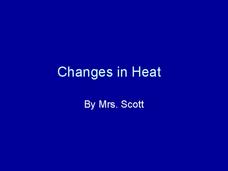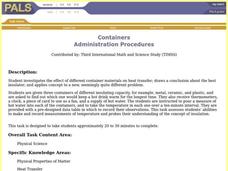Curated OER
Fall 2005 Midterm Exam #1
You've got the power! With this physics midterm, you have the power to assess learners' grasp of electricity concepts. The exam is neatly formatted and provides a variety of question types: true or false, multiple choice, and problem...
Curated OER
Conductors and Insulators
Fifth graders explore conductors and insulators. In this science instructional activity, 5th graders act as electrons moving through a wire. Students break into groups representing conductors and insulators and explore how they work with...
Curated OER
Keeping Warm
There are five separate lessons about heat in this collection of slides. Young scientists learn how to use a thermometer to measure temperature, and they experiment with insulators. You can use one of these lessons each day for a full...
Curated OER
Changes in Heat
A thorough PowerPoint provides information related to changes in heat. The contrast between day and night temperatures is included. The concepts of boiling and freezing are also covered. Insulators and conductors are presented as well.
Curated OER
Electricity
Twenty-one slides cover all aspects of electricity; from electric charge, to protons, lightning, currents, the calculations for wire resistance, circuits, household devices, and fluorescence. The amount of detail and the range of...
Curated OER
Electricity
Give your science lesson a charge with this presentation on electricity. Each slide contains vocabulary or great information on what electricity is and how it works. Note: This resource would be even better if accompanied by a video and...
Curated OER
Thermal Energy
Explore thermal energy with your class with this introductory presentation. While there is information about heat, conduction, temperature and other topics, further information could be added to make it a richer experience.
Curated OER
Conductors and Insulators
In this conductors and insulators worksheet, learners answer 11 questions about electrical resistance, conductance, gauge scale, and breakdown voltage.
Curated OER
Electric Gameboards
Students explore the properties of electricity. In this electricity lesson, students construct an electric game board circuit using their knowledge of a series electrical circuit. Students develop game ideas based on current...
Curated OER
Electricity: Static and Current
Students investigate static and current electricity. In this electricity lesson plan, students observe 4 demonstrations and conduct 3 activities to explore the repulsion of electrons and the attraction of protons and electrons. They...
Curated OER
Heat Discrepancies
Students answer the question, "Why do Eskimos build houses out of ice to keep warm. Since heat goes from hot to cold, don¿¿¿t the ice walls take away the warmth inside the house?" They explain how snow or ice can actually be insulators.
Curated OER
Conductors and Insulators Experiment
In this conductors and insulators experiment worksheet, students follow the procedures to set up an experiment that tests which common materials are conductors or insulators.
Curated OER
Circuits and Conductors
Fourth graders investigate the concepts of circuits and conductors. In this circuits and conductors lesson set, 4th graders watch demonstrations of circuits and look at images to identify whether they are complete circuits. They test...
Curated OER
Introduction to Electricity
In this introduction to electricity worksheet, students define several key terms related to electricity. Students list examples of conductors and insulators in a chart. Students create insulators using given materials and describe the...
Curated OER
How is Thermal Energy Transferred?
In this thermal energy worksheet, students will write down the key facts and vocabulary words associated with heat and thermal equilibrium, transfer of thermal energy, conductors and insulators, and heat capacity. This worksheet is a...
Curated OER
Insulators And Conductors
Students investigate the flow of electricity and how it effects different objects in the classroom as being classified as an insulator or conductor. They work in teams to test the conductivity of different classroom objects after making...
Curated OER
Conductors, Insulators, and Semiconductors
Students will investigate the differences in conductivity of materials, design a variety of complete circuits, and observe the differences between the manner in which light is produced in an incandescent light bulb and an LED.
Curated OER
Conductors and Insulators
Fifth graders investigate conductors and insulators by testing their hypotheses. They use copper wire and batteries to light a bulb. They use a penny and a plastic spoon to determine which is an insulator and which is a conductor.
Curated OER
Let it Shine
Fifth graders investigate concepts of electricity by watching a video about Ben Franklin, participating in a web activity about simple circuits and experimenting with creating simple circuits. They examine conductors and insulators.
Curated OER
Conductors and Insulators
Young scholars describe safe practices that are appropriate to a range of situations and environments. They discuss how electricity runs through wires that are insulated so that it cannot escape and determine that you can get...
Curated OER
What Makes Good Long Undies?
Students examine a variety of different types of fabrics and discuss what characteristics would make a good pair of long underwear for a journey to Antarctica. They investigate the properties of various fabrics and determine how they...
Curated OER
Highways and Stop Signs
Fourth graders investigate conductors and insulators and distinguish between the two. They utilize the digital camera and other forms of technology to create a study guide on conductors to help students develop sound knowledge.
Curated OER
Containers
Pupils investigate the effect of different container materials on heat transfer; draws a conclusion about the best insulator; and applies concept to a new, seemingly quite different problem.
Curated OER
A Hair Raising Experience
Students rotate through various lab stations in groups as they experiment with the concepts of conduction, induction and friction. They use a generator, aluminum pie pans, paper, plastic, styrofoam and other materials to complete their...

























